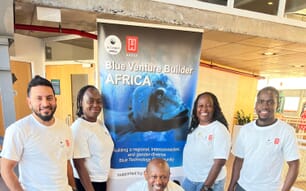Identity
Clarias Gariepinus Burchell, 1822 [Clariidae]
FAO Names: En - North African catfish, Fr - Poisson-chat nord-africain, Es - Pez-gato
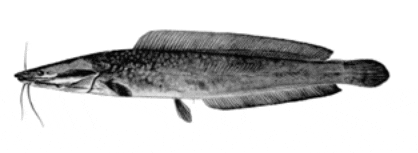
Biological Features
Body elongate. Head large, depressed and bony with small eyes. Narrow and angular occipital process; gill openings wide; air-breathing labyrinthic organ arising from gill arches; first gill arch with 24 to 110 gillrakers; cleithrum pointed, narrow with longitudinal ridges and with sharpness. Mouth terminal, large. Four pairs of barbels present. Long dorsal and anal fins; without dorsal fin spine and adipose fin. Anterior edge of pectoral spine serrated. Caudal fin rounded. Colour varies from sandy-yellow through gray to olive with dark greenish-brown markings, belly white.
View SIDP Species fact sheet
Images Gallery
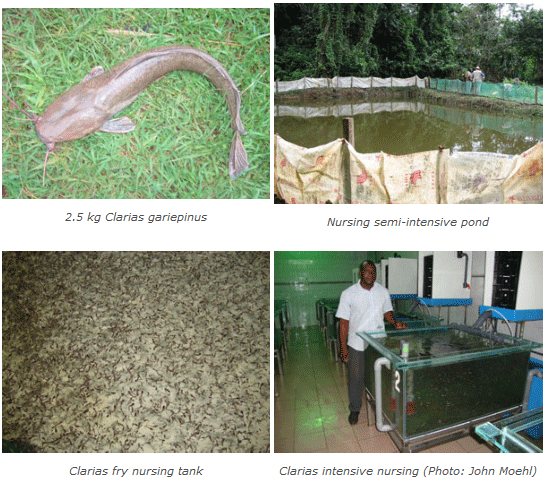
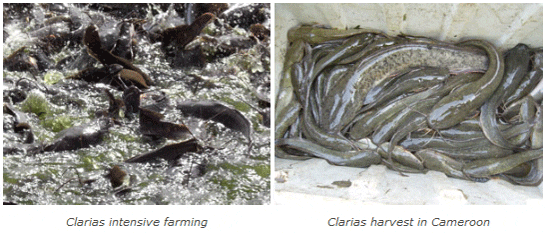
Profile
Historical Background
African catfish are mentioned within traditional capture-based aquaculture (known as wheddos in Benin and Ghana and barochois in Mauritius) for centuries. Their culture in modern times follows a similar trend to that of tilapias: first domestication trials by the year 1950 and adoption of the North African catfish Clarias gariepinus as the most desirable catfish for aquaculture in the mid 1970s. However, under culture conditions, it is difficult for the fish to spawn spontaneously. Protocols for artificial propagation based on hormonal stimulation were therefore developed from the 1980s. Research on the development of farming technology has been conducted in Europe (Belgium and the Netherlands) as well as in Africa (e.g. Central African Republic, South Africa, Côte d’Ivoire, Nigeria).
For many reasons, including the current availability of this species in almost all its water bodies, a huge expanding population with increasing demand for fish and its superior technical skill and infrastructures compared to other African countries, Nigeria has certainly benefited by far the most from these research studies.
Generally, Clarias gariepinus have mostly been used as ‘police-fish’ to control over-breeding in mixed-sex tilapia culture in earthen ponds. In Uganda, the development of Clarias culture is more related to its use as baits for fishing in Lake Victoria.
More recently, with the development of balanced extruded feed, there has been a huge diversification of culture environment in most African countries where this catfish is reared, including the use of concrete or fibreglass tanks and water recirculation systems.
Main Producer Countries
The map shown below is constructed from FAO reported statistics for this species. Farming activities also occur in other countries including China, Thailand, Egypt, Uganda.
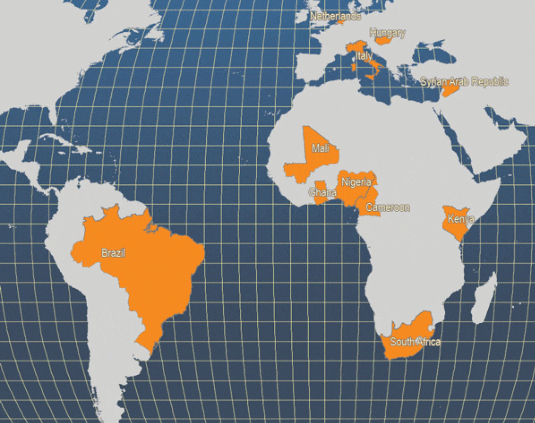
Main producer countries of Clarias gariepinus (FAO Fishery Statistics, 2006)
Habitat and Biology
North African catfish (generally referred to simply as ‘African catfish’ in the rest of this fact sheet) have almost pan-African distribution (but are naturally absent from the Maghreb, Upper and Lower Guinea and Cape provinces). They are equally present in Jordan, Lebanon, Israel and Turkey. Clarias gariepinus has also been introduced into most other countries in Africa, as well as several in Europe, Asia and South America. Similarly to other species, China has adopted it within its rice-fields and is currently among the main producing countries, even though this species does not appear separately in its production statistics.
This species is found in lakes, streams, rivers, swamps and floodplains, many of which are subject to seasonal drying. The most common habitats are floodplain swamps and pools where they can survive during the dry season(s) due to their accessory air breathing organs. Clarias gariepinus undertake lateral migrations from the larger water bodies, in which they feed and mature at about the age of 12 months, to temporarily flooded marginal areas in order to breed. These reproductive migrations typically take place shortly after the onset of the rainy season(s). The final gonadal maturation is associated with rising water levels. Under stable environmental conditions, adult C. gariepinus have mature gonads year-round. Under ideal conditions, a ripe female may lay about 60 000 eggs/kg. Prior to mating, males compete aggressively for females with which they mate in single pairs, the female swishing her tail vigorously to mix the eggs and sperm and distribute the fertilized eggs. The adhesive eggs stick to submerged vegetation and hatch in 20–60 hours, depending on temperature. The yolk sac is absorbed within 3–4 days and the stomach is fully functional within 5–6 days after onset of exogenous feeding. Sexual differentiation begins between 10 and 15 days after hatching. Larvae feed and grow rapidly in the warm (usually >24 °C) nutrient rich floodplains, reaching 3-7 g within 30 days. As flooded marginal areas dry up with the end of the rains, juveniles and adults make their way back to deeper water. In areas with two rainy seasons, there are usually two reproductive peaks during the year, corresponding in intensity to the magnitude of the rains.
Stomach contents of Clarias species typically include insects (adults and larvae), worms, gastropods, crustaceans, small fish, aquatic plants and debris, but terrestrial seeds and berries, and even birds and small mammals, have also been observed. Larvae are almost exclusively dependent on zooplankton for the first week of exogenous feeding. Large C. gariepinus, because of their high number of gillrakers, also target zooplankton as a primary food source. Although generally omnivorous, C. gariepinus relatively better digests high-protein diets than carbohydrates. Most species of Clarias are slow foraging predators, with very small eyes, using their four pairs of barbels to feel their way around in the dark and find food detected by the array of sensitive taste buds covering the barbels and head. Approximately 70 percent of feeding activity takes place at night. Research in South Africa showed that removal of the barbels reduced feeding efficiency in C. gariepinus by 23 percent. In general, Clarias catfishes capture their prey by gulping them with a rapid opening of the mouth and then retaining them either on the gillrakers or fine recurved teeth arranged on dentary, premaxillary, vomerine and pharyngeal bands. C. gariepinus exhibits a variety of feeding strategies including sucking the surface for terrestrial insects and plant fragments washed into the water by heavy rains and pack-hunting of small cichlids. Growth is relatively rapid, approaching maximum size within a couple of years. First year growth is nearly linear resulting in the large initial jump in size.
Production
Production Cycle
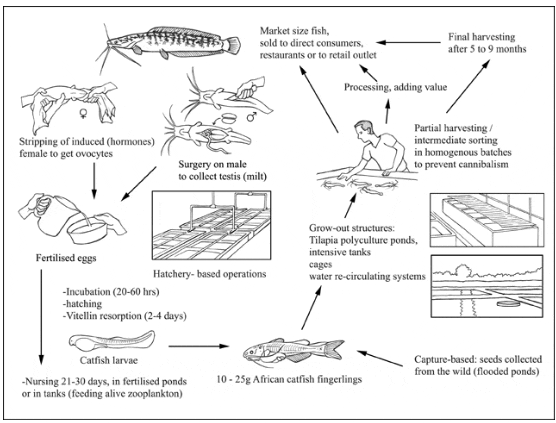
Production cycle of Clarias gariepinus
Production Systems
North African catfish are reared in ponds and in concrete, fibreglass and plastic tanks, with various levels of intensification. Traditional flooded ponds, where naturally recruited fingerlings are gathered during the rainy season and exogenous feed is provided, constitute a form of capture-based aquaculture. The following sections of this fact sheet describe the production systems used in Cameroon and Nigeria, which are similar to those used in most producing countries.
Seed Supply, Hatchery Production and Nursery
African catfish reproduce in response to environmental stimuli such as a rise in water level and inundation of low-lying areas. These events do not occur in captivity and hormone treatment is employed to ensure large-scale production of catfish fingerlings. The hormones used include Ovaprim, Deoxycorticosterone Acetate (DOCA), Human Chorionic Gonadotropin (HCG), pituitary glands from catfish brooders, common carp, Nile tilapia and even frogs, following specific technical procedures. The governments of Nigerian and Cameroon are currently supporting research to develop and maintain good parental broodstock to supply all the needs of private fingerlings producers as well as to facilitate the quality control of the fish seed marketed.
In extensive hatcheries, larvae are fed with a mixture of cow brain plus egg yolk just after vitelline resorption for 4-6 days before being stocked at 50-80/m2 in nursery ponds fertilised beforehand (usually with chicken manure) to enhance zooplankton development. Small-scale farmers stock the postlarvae obtained from these procedures in ponds protected from predators by fencing.
Postlarvae are fed with single ingredients or compounded feed. Harvesting is carried out after 24-28 days and fingerlings are graded; the average weight at this stage is 5-7 g. Since the recommended size at transfer to production ponds should be >10 g, additional pre-fattening may be carried out except when the volume of immediate demand drives hatchery operators to sell the fingerlings at 6 g. Normally, survival in properly managed nursing systems averages 25-35 percent.
In well-managed ponds over 20 000 fingerlings/kg of female brooder can be produced with an average weight of 5 g. Although the procedures are being simplified, only a few farmers have been exposed to new methodology. Consequently, the price of catfish fingerlings remains high (USD 0.15-0.25 each in Cameroon) and most farmers prefer to collect wild seed when available; unfortunately, these fingerlings often consist of mixed species of Clarias and some, such as C. jaensis, exhibit comparatively lower growth rates.
Large-scale hatcheries in Nigeria have developed intensive recirculation systems, using genetically-improved broodstock along with live feeds (Brachionus, Moina, Daphnia, Artemia) developed within the farms. Fry are kept at 5 000-15 000/m3 and up to 75 percent fish to egg survival is recorded. These hatcheries offer good quality catfish fingerlings at USD 0.1-0.2 each, depending on size. However, since the demand for catfish fingerlings often exceeds the supply, many small-scale hatcheries tend to care little about the quality of the seed they offer. Poor quality seed has discouraged many small-scale grow-out commercial farmers.
In the recirculation aquaculture systems (RAS), fry (0.05-0.1 g) are fed with Artemia and 0.25 mm fry feed for 14 days in 100-1 000 litre tanks (600 g/m3 stocking density). Then, advanced fry (0.1-1.0 g), stocked at 10 000/m3, are fed 0.3-0.8 mm dry feed for 26 days in 600-1 000 litre tanks. Juveniles (1-8 g) are reared in 600-6 000 litre tanks at 400/m3 for 20 days and fed 0.8-1.5 mm dry feed. Water temperature is maintained at 28 °C, pH at 7, and biofilters ensure that NH3 and NO2 levels remain below 3 and 1 mg/litre respectively. To avoid disease problems, all components of the system are disinfected between each cycle.
In most catfish producing countries, hybrids named Heteroclarias are available from hatcheries that have fertilised oocytes collected from Heterobranchus longifilis females with milt from Clarias gariepinus. The resulting fry usually show improved growth compared to the parental species. However, they are unable to reproduce, even when artificial breeding techniques are used. In addition, this hybrid is reported to exhibit aggressive behaviour and large variations in body weight. This makes them prone to poor survival rates in grow-out ponds; cannibalistic behaviour is commonplace in Clarias species.
Ongrowing Techniques
Many different systems are used for ongrowing African catfish, including those detailed below.
Traditional flooded ponds
For the flood ponds in the Nkam Valley in Cameroon (locally known as Mbeuth), pond preparation is performed just after traditional rituals at the end of the dry season, with the extraction of the bottom mud and rehabilitation of the fish shelters. Sunshine stimulates natural productivity before the start of the next rainy season in early April. Weedy grasses and shrubs invade the sites (the main shrub being Alchornea cordifolia) in April-July. In normal years, flooding of the Nkam River and its tributaries occurs in July-October. Flood ponds are inundated at that time and fish recruit naturally to find the necessary food and shelter. Supplemental fish feeding is provided by some farmers in December and January, using table scraps or individual industrial by-products such as wheat middling or rice bran. Water retreat starts and ponds are drained and fish harvested from January to March. Average pond size and depth in the Nkam valley are 40 m2 (475 ponds, range 2–240 m2) and 1.7 m (range 0.5 to 3 m), respectively. Most ponds are harvested after a one-year rearing cycle (52 percent) or after 2 years (45 percent). Exceptionally high flood pond production rates are sometimes recorded - up to 860 kg/100 m2/year of fish (consisting of 75 percent C. jaensis, 20 percent C. gariepinus, and 5 percent Channa obscura plus Oreochromis sp.).
Catfish holes in Bangladesh and Nepal
African catfish were unofficially introduced into Nepal in 1996-97 by fry traders from India and Bangladesh. Their culture has been expanding rapidly since early 2000s. Recently, culture in small pits or ditches has been promoted by NGOs and other organizations. Research trials were set up in 1-2 m3 sized ditches at first. Now, private ponds/ditches vary from 1 m2 to 2 500 m2 with no specific design. According to unconfirmed sources, catfish fry are transported all the way from Calcutta, India and from Bangladesh, but some Nepalese farmers have already started producing hatchlings. With stocking rates of 1 g fry at 40-80/m3, harvests of 200-300 g fish with 30-50 percent survival rates are recorded after 5-7 months rearing. This equates to a production rate of ~40-60 tonnes/ha. This is slightly higher than in Bangladesh. Clarias gariepinus reared alongside with the local C. batracus are fed with offal, bread, mustard oilcake, maize flour, and restaurant garbage. About 300 tonnes is said to be produced in Nepal in 2010. However, this alien, carnivorous and predatory species is a threat to the native fish of Nepal.
Polyculture Ponds in Earthen Ponds
African catfish fingerlings, preferably homogenous batches with individual weights of >10 g, are stocked into mixed-sex Nile tilapia grow-out ponds. The stocking density that allows good predation of tilapia offspring is 0.5-1 catfish: 2 tilapia. Usual stocking densities remain below 5/m2 (or 50 g initial biomass/m2) but exceptionally higher rates may be used (10-15/m2) when mechanical aeration is available. Ponds are fertilised and feeding is applied for 6 to 11 months before the harvesting and marketing of table fish. For small-scale rural farmers stocking is performed during January to March and harvesting targets marketing for the Christmas and New Year festivities. Such ponds are fertilised using a compost crib covering 10 percent of the pond surface and regularly loaded using miscellaneous organic leftovers that are available within the farm (kitchen refuse, rotten fruit, dead slaughtered land animals, manure from land animal husbandry, etc.).
In and around big cities, there are many commercial ponds with harvesting scheduled throughout the year. Ponds may also be partially harvested and marketable fish are removed by seining. Low survival rates have been observed in relation to heterogeneous growth in African catfish population, with larger individuals preying on smaller ones. Grading is therefore performed during intermediate sampling and partial harvesting, to ensure more homogenous pond populations. These ponds also receive organic fertilizers (mainly dried poultry manure) to induce the development of natural feed. Exogenous feed consisting of individual ground industrial by-products (wheat or rice bran, cotton cake) or standard compounded pellets (4-8 mm diameter, 28-35 percent crude protein, usually animal protein-free) are provided. The feeding rate may be as high as 6 percent of the estimated fish body weight daily for the first few months but it is gradually reduced as the fish grow to 80 percent. Because adult African catfish can escape from ponds towards neighbouring natural water bodies to spawn, fine-mesh fences should line the inner banks of the ponds. Production in tilapia- catfish polyculture ponds varies from 3-4 tonnes/ha/yr in rural low input level ponds to 10-25 tonnes/ha/yr in peri-urban areas with higher input loading and follow-up capabilities.
Tanks and Raceways
Although most farmers of African catfish are pond owners, the greatest production volume of this fish in Nigeria derives from peri-urban concrete tanks and raceways where there are fewer input availability constraints (rearing infrastructures, power, seed, feeds, specialised manpower, market access). The development of these systems is linked to the hardiness of the species, which include its ability to withstand low DO2 levels.
In the typical backyard 4 m x 3 m x 1.3 m concrete tank of a Nigerian city-dweller, 400 catfish fingerlings of 5-15 g are stocked, and fed with a balanced diet for 6 months. The water is renewed once or twice per week and a production of 300-600 kg/cycle is recorded, varying according to the skill of the fish farmer.
Water recirculation systems have been developed in recent years: economically successful farms are reported in Nigeria but the poor availability of floating feed is a limiting factor. Fish are currently fed with imported floating feed for 3-5 months, followed by standard locally-made pellets until harvest. Future prospects suggest optimism, with a current public-private partnership initiative supported by consistent loan facilities from the World Bank in favour of the Nigerian catfish industry. In water recirculation systems, which consist of an electric pump and a plastic substrate biological filter, fingerlings are stocked at 80-200/m3 and the recirculation rate is 2-10 litres/second. Production rates of >1000 kg/m3/yr have been recorded in these systems.
In Europe (specifically in the Netherlands and in Belgium), African catfish are produced through recirculation aquaculture systems (RAS) that have the following general features. Borehole freshwater is stored and heated in indoor concrete, fibreglass or plastic tanks. Water requirements average 0.15 m3/kg fish. Little land is required. Rearing water is purified by the use of plastic substrate biological filters. These systems are highly intensive, with 700 to 1000 kg/m3 of fish obtained while using extruded balanced feed plus small and regular cropping. The only significant technical difference between these systems and those used in the large Nigerian cities of Lagos and Ibadan are that latter do not require artificial heat. However, the need to import extruded feed and other miscellaneous production infrastructures and equipment results in relatively high production costs for fish reared in such systems in African countries to date (2010).
Cages
In some Asian countries, African catfish are reared in cages using balanced feed. In this case, tilapias are often stocked in the open waterbodies to prevent eutrophication.
Feed Supply
Typically, the individual (fed singly) industrial by-products used in pond culture that have been mentioned previously include rice bran, wheat middling, cottonseed meal, corn meal and peanut (groundnut) meal. Farm-made pelleted feeds, typically 28-35 percent protein, consist of various combinations of these by-products, together with other ingredients such as brewery drafts, cacao husk, coffee pulp and chicken droppings. When the ponds are well fertilised, such unusual plant proteins have been used at up to 20 percent of the compounded feed without significant deleterious effects on fish production. Very little, if any, animal protein (e.g. fish meal, blood meal) is currently employed in grow-out feeds for African catfish in fertilised ponds. Other farm-made feedstuffs include maggots, termites, earthworms and crickets.
When requested, national and international feed companies provide specifically formulated catfish feeds. These are mostly used in concrete, fibreglass and plastic tanks as in-line ponds and raceways. The best growth rate and FCR are achieved with diets containing 35-42 percent crude protein and 12 kJ/g feed.
With the current development of recirculation systems balanced sinking fish pellets are not ideal. Extruded feeds that float cause less pollution and are more efficient. However, successful African catfish production in intensive systems is currently closely correlated with imported extruded feed from Europe and Brazil. Efforts are currently being made to establish extruded feed plants in many African countries (e.g. Nigeria and Uganda).
Harvesting Techniques
African catfish ponds are partially harvested using hauling seines. At this time fish are manually sorted; those that appear significantly larger than average are separated and stocked separately to prevent cannibalism. At the end of the rearing cycle ponds are completely drained and the pond bottom cleaned in order to catch all the fish hidden in the mud. Ponds should be dried between production cycles or carefully inspected to prevent huge levels of cannibalism by any escaped adult catfish on the newly stocked fingerlings of the following cycle. Partial harvests of tanks, raceways and recirculation systems are accomplished with grader bars to remove the largest fish.
Handling and Processing
Handling live African catfish is easy because, as long as the skin remains wet, they can stay alive for many days out of water. Harvested fish are loaded live into hauling pick-ups and taken to city markets. The fish are either sold directly to consumers or most frequently to female retailers (bayam-sellam). In the latter case, fish are loaded into 40 litre containers or in bags before transportation using ordinary passenger or merchandise buses. A minority of producers process the fish before they are sold. Depending on fish size and market demand, the fish may be steaked; filleted; or sold headed, gutted, and skinned. Male African catfish exhibit the best dressing and fillet percentage. Compared to other species, C. gariepinus are low in lipid and consequentially have no intense flavour (smell and taste). Smoked African catfish are also in high demand be because they can be stored for longer periods without power while retaining nutritional quality.
These fish are remarkably resilient. In kitchens and restaurants, inexperienced cooks may be frightened by African catfish that remain alive, since they may jump out of the refrigerator many hours after being placed in them! Spreading some ground salt on the skin may kill the fish in a few minutes; using vinegar to soak the skin also allows better spicing and cooking of the fish. In the Cameroon a black soup (bongo) is specifically adapted to make a very tasty stew using a fresh African catfish.
Production Costs
African catfish can be produced most economically in tropical and subtropical countries, which have favourable temperatures for growth as stated earlier. Production costs in these countries vary from USD <1.0/kg to USD 2.5/kg, depending on the production system. Local demand remains high in most of the producing countries and the fish are generally sold in live fish markets, where higher prices can be obtained. In sub-Saharan Africa, market prices range from USD 2.5-5.0/kg; smoked dried fish commanding higher prices.
Considering the typical catfish polyculture systems in Cameroon ponds, feed and fertilisers account for 54 percent of production costs in peri-urban farms but only 22 percent in rural areas, where the cost of fingerlings and labour are the major items. In recirculation systems, feeds and infrastructure maintenance constitute the major production costs. In grow-out tanks, feed constitutes 75-85 percent of the production costs and needs to be carefully managed to ensure commercial success. In Nigeria, the success of these systems is certainly related to the relatively low cost of fuel to run generators (less than USD 0.4/litre of premium petrol in 2010).
The production costs for African catfish farming in recirculation systems tend to be higher in tropical than in European countries because of the current need to import suitable feeds and equipment. For example, the production cost of an 8 g juvenile in the Netherlands is estimated at
Diseases and Control Measures
African catfish are subject to a wide variety of diseases including bacteria, fungi and miscellaneous parasites. Some of the most important disease organisms are included in the table below, though many of the observed diseases are yet to be fully diagnosed.
| In some cases antibiotics and other pharmaceuticals have been used in treatment but their inclusion in this table does not imply an FAO recommendation. | ||||
|---|---|---|---|---|
| Disease | Agent | Type | Syndrome | Measures |
| Broken head | Unknown | Skeletal deformities (lardosis and scoliosis); fish suddenly stop feeding, become lethargic and die with swollen weak tissues on both sides of the head; usually observed on fish >10 cm; dead fish exhibit thick and curved skulls testifying former lateral crack. | Provide supplemental Vitamin C in feeds | |
| Ruptured intestine syndrome | Unknown | Lethargic behaviour; swollen abdomen; discoloured abdominal skin; reddish anal area; rupture of the abdominal wall at the final stage | Provide sufficient balanced and well conserved diet | |
| Ulcerative disease | Unknown | Skin ulceration; sluggish behaviour; red or white necrotic skin ulcers on the mandible and maxilla and on the caudal peduncule | Proper management system | |
| White spot | Myxobacteria | Bacteria | Fish remain at water surface in vertical position and swim sluggishly; white spots on skin around the mouth and gills | Antibiotics in feed (chloramphenicol, terramycin or oxytetracycline) as preventive measure; subject catfish larvae to furaltadone at 50 ppm/hour |
| Aeromonas septicaemia | Aeromonas hydrophila | Bacteria | Fraying and reddening of fins; de-pigmentation; ulcers | Oxytetracycline; sulfamethoxine; ormetoprin in feeds |
| Motile Aeromonad Septicaemia | Aeromonas sp. | Bacteria | Exophthalmia and distended abdomen; deep dermal ulcers with haemorrhages and inflammation | Avoid stress; use supplemental feed mixed with Trimethoprim and Bactrim for 10 days |
| Water mould | Saprolegnia spp. | Fungi | Grey/white patches on skin, fins, gills and eyes resembling cotton-wool; affected eggs show the same signs; normally small, focal infections spreading rapidly over body or gills | Malachite green bath (5 mg/litre for one hour) or sodium chloride (5% for one to two minutes); avoid mechanical damage and other kinds of stress |
| Parasites | Costia sp., Chilodonella, Trichodina | Protozoans | Fish remain at water surface in vertical position, or nervously scratch the head and side on container bottom; skin covered with a thin whitish grey mucus; massive death can occur | Formalin (25-50 mg/litre); Dipterex (0.25 mg/litre) |
| Parasites | Gactylogyrus sp. Gyrodactilus sp. | Trematodes | Same as protozoans above | Formalin (25-50 mg/litre); Dipterex (0.25 mg/litre) |
| Parasites | Henneguya sp. | Protozoans | In fingerlings of C. gariepinus x Heterobranchus sp. hybrid, white spots on skin and gills observed | Antibiotics in feed (chloramphenicol, terramycin or oxytetracycline) as preventative measure |
| Parasites | Cysticerca sp. | Nematode worms | Worm perforates muscled and viscera; usually found in reservoirs; fish appear not to suffer from presence of this parasite | Unknown |
| Gill and/or external parasites | Trichodina maritinkae | Protozoans | Small white spots on skin or gills; irritation, instability, lethargy, weakness, loss of appetite, and decreased activity; gills pale and very swollen | Formalin or salt solution bath |
Most of the diseases listed above are principally observed within intensive culture. Prevention through avoidance of stress is probably the most effective means of avoiding diseases. So far, virus related diseases have not been reported in African catfish. Chemicals are only used when an epizootic has been detected, and then only for limited periods of time.
Suppliers of Pathology Expertise
Assistance can be obtained from the following sources:
- Government extension agents based in fish farming areas.
- Government laboratories, research stations and universities, e.g. in Cameroon the IRAD fish culture research stations in Foumban (West region) and Lanavet (Garoua, North region), may provide expertise and drugs for the above cited diseases.
Statistics
Production Statistics
Global Aquaculture Production of Clarias Gariepinus
(FAO Fishery Statistic)
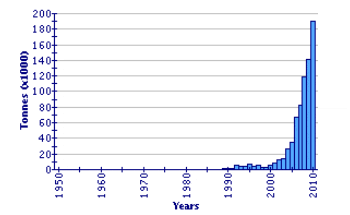
Nigeria is by far the largest producer of farmed North African catfish in official statistics but the Netherlands, Hungary, Kenya, the Syrian Arab Republic, Brazil, Cameroon, Mali and South Africa also produce significant quantities.
Market and Trade
Domestic and foreign market demand for African catfish in European producing countries (Netherlands, Belgium, Hungary) fluctuates widely.
In Nigeria, the current selling price averages USD 3.5/kg. In the central Africa region, namely in Cameroon, Gabon or Democratic Republic of Congo, this fish is very popular, being cooked in many forms of soups, made of some forest seeds with specific tastes and medicinal properties. The fresh fish are usually sold live in the markets of major cities at an average size of 500 g for USD 3.3-5.2/kg.
In South Eastern Africa, catfish prices are a little lower than those for tilapia. In the South African market, the African catfish is not a good seller. There exists some religious aversion by some consumers (who do not eat fish without scales); others reject the fish due to its slightly darker flesh compared to other catfish such as Pangasius.
Other varieties of catfish seem to be doing well in other places in the world. However, it is difficult to obtain prices for African catfish either because this species is not yet traded internationally, or because it has been included in ‘other freshwater fish’ in statistical returns. Some South African growers have recently closed operations down due to production costs exceeding the selling price; basically this is caused by the high price of feeds.
Status and Trends
African catfish appear as the major fish species cultured in sub-Saharan Africa, followed by tilapias. This is obviously related to continual improvement in mass propagation techniques and the development of water recirculation systems, along with quality feed development. Partnership Research (a recently promoted approach linking private farmers and scientists within a partnership to ensure that findings have direct and tangible impacts on production) is being established in order to reduce production costs, with a major focus on floating feed production using locally available by-products and machinery. Another research focus targeting is the genetic improvement of broodstock. The polyculture system appears to be declining in favour of the more intensified tank culture in its various forms (concrete, fibreglass, plastic containers and pond liners, and recirculation aquaculture systems). However, it may be an error to continue focusing on these intensive systems, which generally depend on imported inputs. While developing more efficient diets to decrease the level of nutrients in pond effluents, it is therefore important to continue optimising the co-culture of African catfish with other complementary fish species.
The market for African catfish in sub-Saharan Africa is developing. Demand for fish is continuously increasing, and most major producing countries are substantial importers of fish to meet their population needs. Above 70 percent of cultured African catfish is currently sold fresh. The market will certainly expand through the development of new product forms and value-added processing.
Main Issues
African catfish are produced almost exclusively on private land and in systems that respect environmental regulations. In traditional flooded ponds, native farmers have adopted sustainable practices for decades, and their self organisation within local communities is being facilitated by traditional rulers and non-governmental organisations to protect the fishery resource. In case where ponds or intensive culture facility effluents enter public waters there is an issue of eutrophication that is being addressed, in part, through the development of extruded balanced feeds.
With the recent collapse of the African catfish market in South Africa, it will become more and more important to reduce production costs in order to remain competitive in a fast evolving business. This may occur through a improvements in pond ecosystems rather than continuing with more and more intensive recirculation aquaculture systems and improved feed technology.
Responsible Aquaculture Practices
In general, African catfish culture is conducted responsibly. The industry is controlled by local regulations, and most governments responsible for the sector are asked to comment on requests for state aquaculture permits in situations where navigable waters are involved and where effluents enter public waters. The creation of catfish farmers associations in most producing countries has been encouraged and facilitated. These associations adhere to the tenets of the FAO Code of Conduct for Responsible Fisheries and the FAO Technical Guidelines for Responsible Fisheries (Aquaculture Development). In Asian countries, however, the situation seems rather different, with uncontrolled transfer of the species by small-scale farmers from Bangladesh to Nepal and India having been reported.
References
Bibliography
Billard, R. 2003. From polyculture to co-culture in fish-farming. In C.S. Lee (ed.). Aquaculture: retrospective and outlook – an aquaculture summit, pp 169-200. Asian Fisheries Society, Manila, Philippines & World Aquaculture Society, Baton Rouge, Louisiana, USA.
De Graaf, G.J. & Janssen, H. 1996. Artificial reproduction and pond rearing of the African catfish Clarias gariepinus in Sub-Saharan Africa – a handbook. FAO Fisheries Technical Paper. No. 362. FAO, Rome, Italy. 73 pp.
De Kimpe, P. & Micha, J.C. 1974. First guidelines for the culture of Clarias lazera in Central Africa. Aquaculture, 4:227-248.
De Silva S. & Davy, F.B. (eds). 2010. Success stories in Asian aquaculture. Springer. 222 pp.
Dorey, M., Mikolasek, O., Boureima, A. & Oswald, M. 2002. Savoir-faire paysan et exploitation piscicole de mares temporaires en zone sahélienne: cas du village de Tafouka (Niger). In D. Orange, R. Arfi, M. Kuper, P. Morand & Y. Poncet (éds), Gestion Intégrée des Ressources Naturelles en Zone Inondables Tropicales. pp. 603–619. IRD, Paris, France.
Hogendoorn, H. 1983. The African catfish (Clarias lazera C. et V., 1840). A new species for aquaculture. Dissertation, Wageningen Agriculture University, The Netherlands. 135 pp.
Isyagi, N.A., Veverica, K.L., Asiimwe, R. & Daniels, W.H. 2009. Manual for the commercial pond production of the African catfish in Uganda. USAID-FISH Project. 251 pp.
Little, D.C. & Edwards, P. 1999. Alternative strategies for livestock-fish integration with emphasis on Asia. Ambio, 28:118-124.
Marttín, F. & de Graaf, G. 2001. Poverty alleviation through fish culture: homestead fish culture in Bangladesh. FAO Newsletter No. 27:8-11.
Ponzoni, R.W. & Nguyen, N.H. (eds.). 2008. Proceedings of a Workshop on the Development of a Genetic Improvement Center, Penang, Malaysia. 130 pp. Program for African catfish Clarias gariepinus. WorldFish Center Conference Proceedings No. 1889. The WorldFish Center, Penang, Malaysia.
Pouomogne, V. 2008. Capture-based aquaculture of Clarias catfish: case study of the Santchou fishers in western Cameroon. In A. Lovatelli & P.F. Holthus (eds.). Capture based aquaculture. Global overview. FAO Fisheries Technical Paper. No. 508:3-108. FAO, Rome, Italy.
Stiassny, M.L.J., Teugels, G.G. & Hopkins, C.D. 2007. Poissons d’eaux douces et saumâtres de basse Guinée, oust de l’Afrique centrale / The Fresh Water Fishes of Lower Guinea West-Central Africa. Volume 1. IRD Editions, Paris, France. 800 pp.
October 2012




